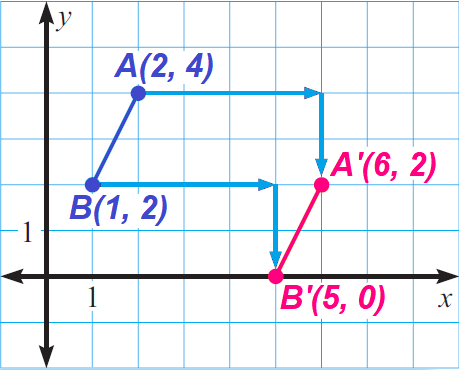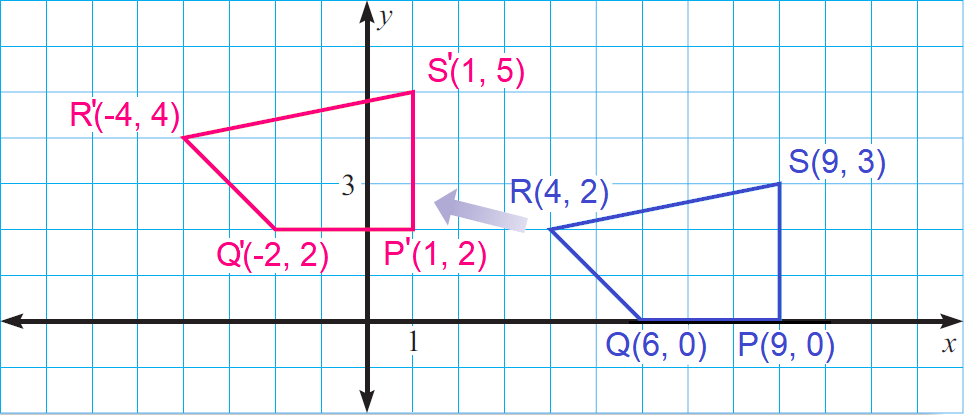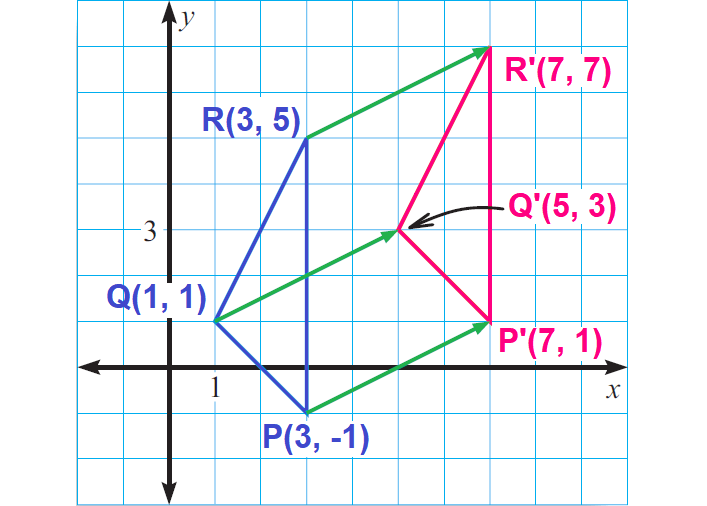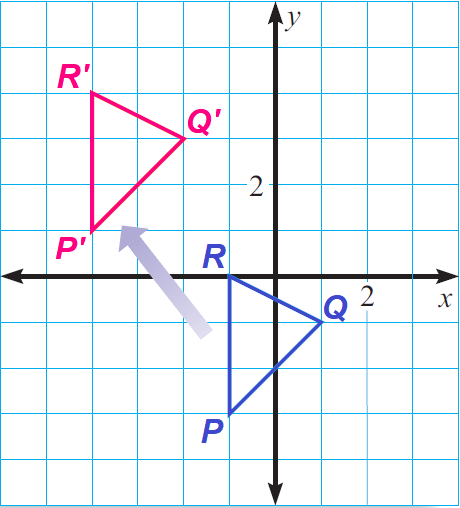TRANSLATIONS IN COORDINATE PLANE WORKSHEET
Subscribe to our ▶️ YouTube channel 🔴 for the latest videos, updates, and tips.
Problem 1 :
Describe the translation in the coordinate plane shown below.

Problem 2 :
Sketch a triangle with vertices P(3, -1), Q (1, 1) and R(3, 5). Then sketch the image of the triangle after a translation to the right by 4 units and up by 2 units.
Problem 3 :
Sketch a triangle with vertices A(- 1, - 3), B(1, - 1), and C( - 1, 0). Then sketch the image of the triangle after the translation (x, y) ----> (x - 3, y + 4).
Problem 4 :
In the diagram shown below, QRST maps onto Q'R'S'T' by a translation. Write the component form of the vector that can be used to describe the translation.


Detailed Answer Key
Problem 1 :
Describe the translation in the coordinate plane shown below.

Solution :
In the coordinate plane shown above, the translation is
(x, y) ----> (x + 4, y - 2)
That is, the translation in the coordinate plane above shifts each point 4 units to the right and 2 units down.
Problem 2 :
Sketch a triangle with vertices P(3, -1), Q (1, 1) and R(3, 5). Then sketch the image of the triangle after a translation to the right by 4 units and up by 2 units.
Solution :
First graph ΔPQR.
We have to do a translation to the right by 4 units and up by 2 units.
So the image vertices should all be 4 units to the right and 2 units up from the preimage vertices.
That is,
P(3, 1) ----> (3 + 4, - 1 + 2) ----> P'(7, 1)
Q(1, 1) ----> (1 + 4, 1 + 2) ----> P'(5, 3)
R(3, 5) ----> (3 + 4, 5 + 2) ----> P'(7, 7)
Label the image vertices P'(7, 1), Q'(5, 3), and R'(7, 7). Then, using a straightedge, draw ΔP'Q'R'.

Problem 3 :
Sketch a triangle with vertices A(- 1, - 3), B(1, - 1), and C( - 1, 0). Then sketch the image of the triangle after the translation (x, y) ----> (x - 3, y + 4).
Solution :
First graph ΔABC.
From (x, y) ----> (x - 3, y + 4), it is clear that we have to do a translation to the left by 3 units and up by 4 units.
So the image vertices should all be 3 units to the left and 4 units up from the preimage vertices.
That is,
P(- 1, - 3) ----> (- 1 - 3, - 3 + 4) ----> P'(- 4, 1)
Q(1, - 1) ----> (1 - 3, - 1 + 4) ----> Q'(- 2, 3)
R(- 1, 0) ----> (- 1 - 3, 0 + 4) ----> R'(- 4, 4)
Label the image vertices P'(- 4, 1), Q'(- 2, 3), and R'(- 4, 4). Then, using a straightedge, draw ΔP'Q'R'.

Problem 4 :
In the diagram shown below, QRST maps onto Q'R'S'T' by a translation. Write the component form of the vector that can be used to describe the translation.

Solution :
Choose any vertex and its image, say R and R'. To move from R to R', we have to move 8 units to the left and 2 units up.
So, the component form of the vector is
〈-8, 2〉
Subscribe to our ▶️ YouTube channel 🔴 for the latest videos, updates, and tips.
Kindly mail your feedback to v4formath@gmail.com
We always appreciate your feedback.
About Us | Contact Us | Privacy Policy
©All rights reserved. onlinemath4all.com
Recent Articles
-
AP Calculus BC Problems with Solutions
Dec 20, 25 10:51 AM
AP Calculus BC Problems with Solutions -
AP Precalculus Problems and Solutions (Part - 1)
Dec 20, 25 10:49 AM
AP Precalculus Problems and Solutions (Part - 1) -
AP Calculus AB Problems with Solutions (Part - 1)
Dec 20, 25 10:49 AM
AP Calculus AB Problems with Solutions (Part - 1)
